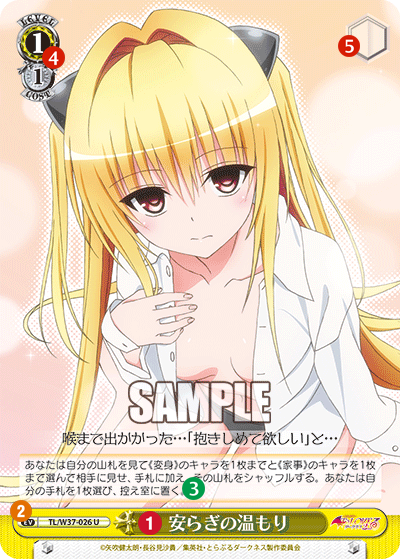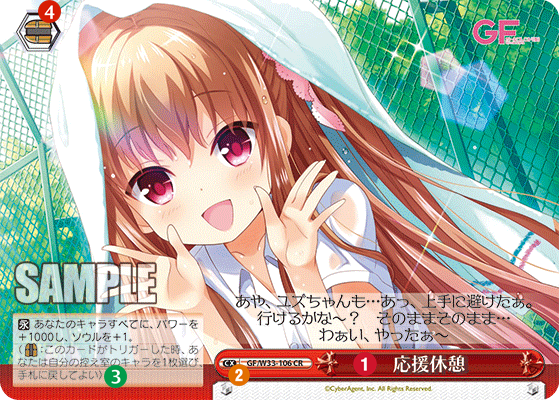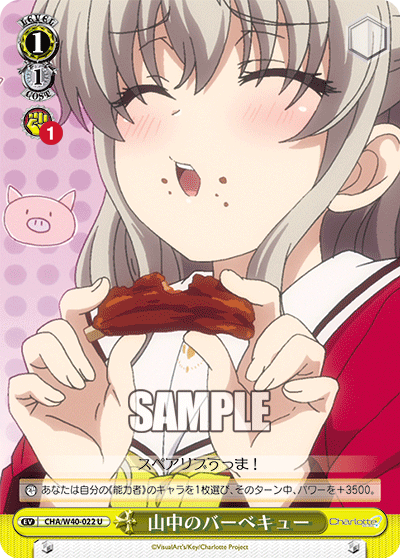Cards in Weiss Schwarz comes in exactly three different categories: Character Cards, Event Cards and Climax Cards. As discussed in the previous post, a deck must consist of exactly 50 cards and 8 of them have to be climax cards. This post will break down each individual card type with an example while explaining each parameter on each card type.

The card above is a character card. Each component will be explained based on the highlighted number.
- Name: This is the name of the character card, “Kaleidoscope” イリヤ. To the right of the name lies the logo from which set the card is based upon.
- Card Code: This area is where the card code is listed along with rarity. The code of the card begins with the set symbols followed by the set distinction, Weiss or Schwarz along with the type of booster, the set number, the card code number and the rarity type. For this card, the code is PI (set symbol), SE (schwarz, extra booster), 18 (set number), card code number (17) and the rarity (SP-SP). That combines to PI/SE18-17SP-SP. To the left of the card code likes the symbol, CH which stands for character. Underneath the card code lies the power value of the card which is in this case, 10000.
- Soul Value: The icons here signify the number of soul damage the character card possesses. There are two soul icons meaning that there are two soul damage on this card.
- Archetype/Attribute: These two tags define the archetype or attribute that the card belongs to. The card here is both a マスター (Master) and 魔法 (Magic).
- Card Effect: This is where the effects of a card are located. Cards have various effects with symbols printed on them with the following:【自】= automated effect, 【起】 = activated effect and 【永】 = continuous effect.
- Level Zone: This area is where the level of the card is printed along with the stock cost just below it. Cards can only be played from hand if the level of the card is equal or less than your current level. The stock costs are an additional cost that needs to be payed to play the card.
- Soul Trigger: This marker signifies whether or not the card provides an additional soul damage during the trigger step.

The card above is an event card. Just like with the character card, this card will also explain its components based on the highlighted numbers.
- Name: This is the name of the event card, 安らぎの温もり. To the right of the name lies the logo from which set the card is based upon.
- Card Code: This area is where the card code is listed along with rarity. The code of the card begins with the set symbols followed by the set distinction, Weiss or Schwarz along with the type of booster, the set number, the card code number and the rarity type. Unlike character cards, event cards do not possess any power as they do not get played onto the field but rather into a resolution zone. The two letter symbol left of the card code is EV which stands for event.
- Card Effect: This is where the effects of the card are located. Unlike character cards, most events do not carry the same symbols, however it is possible for events to give characters effects that will carry those same symbols (【自】, 【起】,【永】)
- Level Zone: This area is where the level of the card is printed along with the stock cost just below it. Cards can only be played from hand if the level of the card is equal or less than your current level. The stock costs are an additional cost that needs to be paid to play the card.
- Soul Trigger: This marker signifies whether or not the card provides an additional soul damage during the trigger step.

The above card is a climax card. Unlike the other two types of cards, this card is the only one that comes in sideways. There must be exactly 8 copies of these cards in your deck. The four of rule also applies to climax cards as well.
- Name: This is the name of the character card, 応援休憩.
- Card Code: This area is where the card code is listed along with rarity. The code of the card begins with the set symbols followed by the set distinction, Weiss or Schwarz along with the type of booster, the set number, the card code number and the rarity type. Unlike character cards or event cards, the logo for the series for climaxes is rather to the top right of the card. The two letter symbol left of the card code is CX with stands for climax.
- Card Effect: This is where the effects of the card are located. Similar symbols of 【自】= automated effect, 【起】 = activated effect and 【永】 = continuous effect are also found on climax cards as well.
- Trigger Effect: Unlike character cards and event cards, climaxes have a variety of different triggers with their own unique effects aside from soul damage triggers. They do however still adhere to the same rules of the trigger step, only applying their trigger effect when triggered. (The trigger symbol effects will be explained in another post)


GRI/S72-056S-SR えっちなお姉さん 天音 (left), CHA/W40-022U 山中のバーベキュー (right)
The above cards are respectively character cards and event cards. However, there’s a special catch to them in the fact that there is a fist symbol in the top left corner below the stock costs of the card.
The fist symbol notes that this card can be used during the opponent’s trigger step in addition to its normal playtime during your turn. These cards are treated normally as your average character card or event card, being played onto the field or the resolution zone. However, when used as a backup meaning having its effect used during the opponent’s trigger step, the cards can be used to provide an effect that can change the tide of combat or board state. Character backups when used as a backup are placed directly into the waiting room. Event backups will resolve their effect in the resolution zone and then enter the waiting room.
**Note: Character backups can be played as a backup without adhering to normal colour rules, but they still follow colour rules when played onto the field as a character card. Event backups must adhere to colour rulings at all times.**